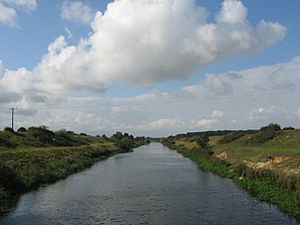Wretton SSSI facts for kids
| Site of Special Scientific Interest | |
 |
|
| Area of Search | Norfolk |
|---|---|
| Interest | Geological |
| Area | 20.6 hectares (51 acres) |
| Notification | 1985 |
| Location map | Magic Map |
Wretton SSSI is a special place in Norfolk, near Downham Market. It covers about 20.6 hectares, which is like 28 football fields! This area is called a Site of Special Scientific Interest (SSSI) because it's super important for understanding Earth's history.
Scientists study Wretton SSSI to learn about geology. Geology is the study of rocks, soil, and how our planet has changed over millions of years. This site is also part of the Geological Conservation Review, which means it's one of the best places in Britain to see certain geological features.
Wretton SSSI: A Window to the Ice Age
This amazing site helps us look back in time, about 115,000 years ago. It shows us the period when the Earth was changing from a warm time to a very cold time. These periods are called the Ipswichian (warm) and the Devensian (cold).
The rocks and soil layers here show us exactly how the climate changed. It's like a giant history book written in the ground!
Ancient Animals of Wretton
Wretton SSSI is famous for its incredible collection of ancient animal bones. These bones are called fossils. They are the remains of animals that lived during the early part of the Devensian, which was a very cold period, like an Ice Age.
Scientists have found many different kinds of animal fossils here. It's the best place in Britain to find these early Ice Age animal remains. Some of the cool animals found include:
- Arctic fox: A small fox that lives in cold, snowy places.
- Bison: Large, powerful animals, similar to modern buffalo.
- Woolly rhinoceros: A huge, hairy rhino that lived in cold climates.
Finding these fossils helps us understand what life was like when the Earth was much colder. It tells us which animals roamed the land in Britain long, long ago.
Visiting Wretton SSSI
If you want to explore this historic site, there's a footpath. It runs along part of the boundary of Wretton SSSI. This path lets you see some of the area where these amazing discoveries were made.

